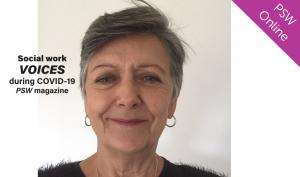Why we need PPE - a heartfelt plea from a former Principal Social Worker

Professional Social Work magazine - 24 April, 2020. Share your COVID-19 experiences here.
The risk of contracting COVID-19 has resulted in the practice of social distancing. We must isolate at home if we are not essential workers and those on the frontline must use personal protective equipment (PPE) wherever provided.
Much publicity has been given to the plight of NHS workers whom I have the greatest respect for. It has resulted in financial recognition, public acknowledgement and finally PPE for most.
The concern I feel compelled to raise is that of the ‘risks’ that social workers and the children they work with are exposed to.
Social workers have no protective equipment. However, their day-to-day duties and responsibilities have not changed during the COVID-19 pandemic. ‘Children need’ or ‘children in need of protection’ must be seen within national procedures.
Assessments, ‘child seen home visits’ and ‘direct work’ must be completed within appropriate and proportionate timescales. Children are required, within the legislation, to be seen alone, their bedrooms and home environment viewed and reported on.
This work continues without the protection of PPE for the social worker or vulnerable children and their families. Social workers are informed they are next in line for PPE, following workers in care homes.
I was told recently of a mother who has three children, aged six and three years old and four months. The eldest child has physical disabilities and is allocated a social worker within the disabled children’s team.
All three children have been assessed as ‘children in need’ due to neglect. The mother of the children has raised concerns regarding home visits as all three of them are very vulnerable to COVID-19.
Questions asked by the mother: do I have to allow social workers, who have no protective equipment, to visit my home? will I be breaking the law if I refuse a home visit?
Questions asked by the social worker: how do I keep myself and these children (and all children on my caseload) safe during my visits? How do I keep myself safe while visiting, assessing and completing direct work with children? Social work managers do not have the answer.
Do we think we are meeting our social obligation, to provide safety and appropriate care, to the most vulnerable children and families by putting social workers next in line for PPE? By telling them to carry on the good work and in the meantime say you must not touch your face until you are in a position to wash your hands, by simply telling them to wash their hands as often as possible? Do those in position of power have an understanding of the environments social workers often find themselves working in?
Isolation and social distancing carries the highest level of risk to children subject to abuse and or neglect. Those who are not being seen in school or by friends and relatives have always been the children we are ‘worried’ most about. If they are not seen, because social workers cannot protect themselves, the risks escalate.
Victims of domestic abuse are at high risk. Isolation is the tool perpetrators of domestic abuse use to assert power and control over victims. If victims of domestic abuse are not being seen, for example at the school gates or other opportunities outside of the home, they are in real and great danger.
Please raise the profile of risk and gain support for the people on the frontline who have yet to be recognised, respected and protected.
Do you have experiences, thoughts or feelings of social work during the COVID-19 pandemic you would like to share with Professional Social Work magazine? Click here to find out how
This article is published by Professional Social work magazine which provides a platform for a range of perspectives across the social work sector. It does not necessarily reflect the views of the British Association of Social Workers.
